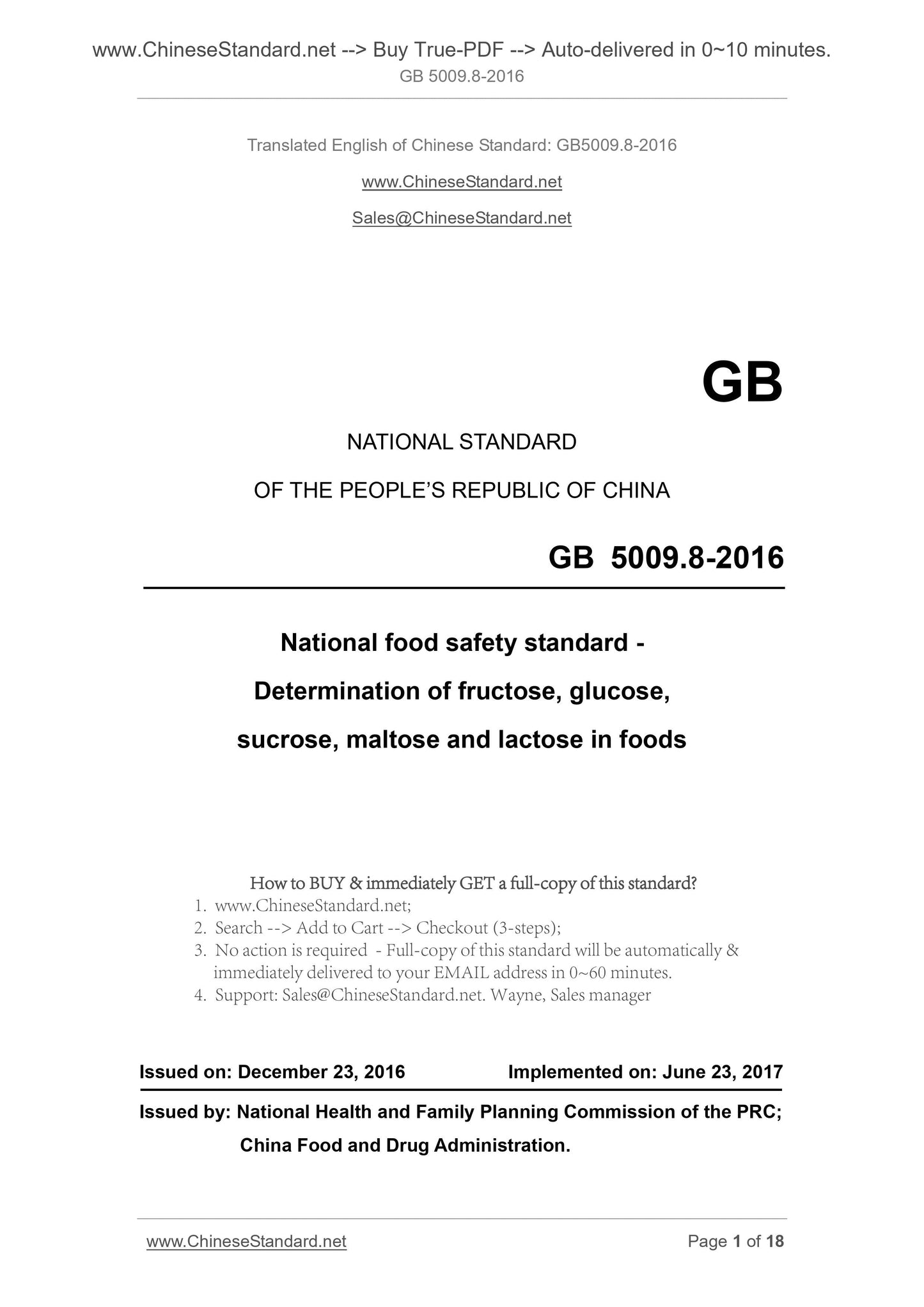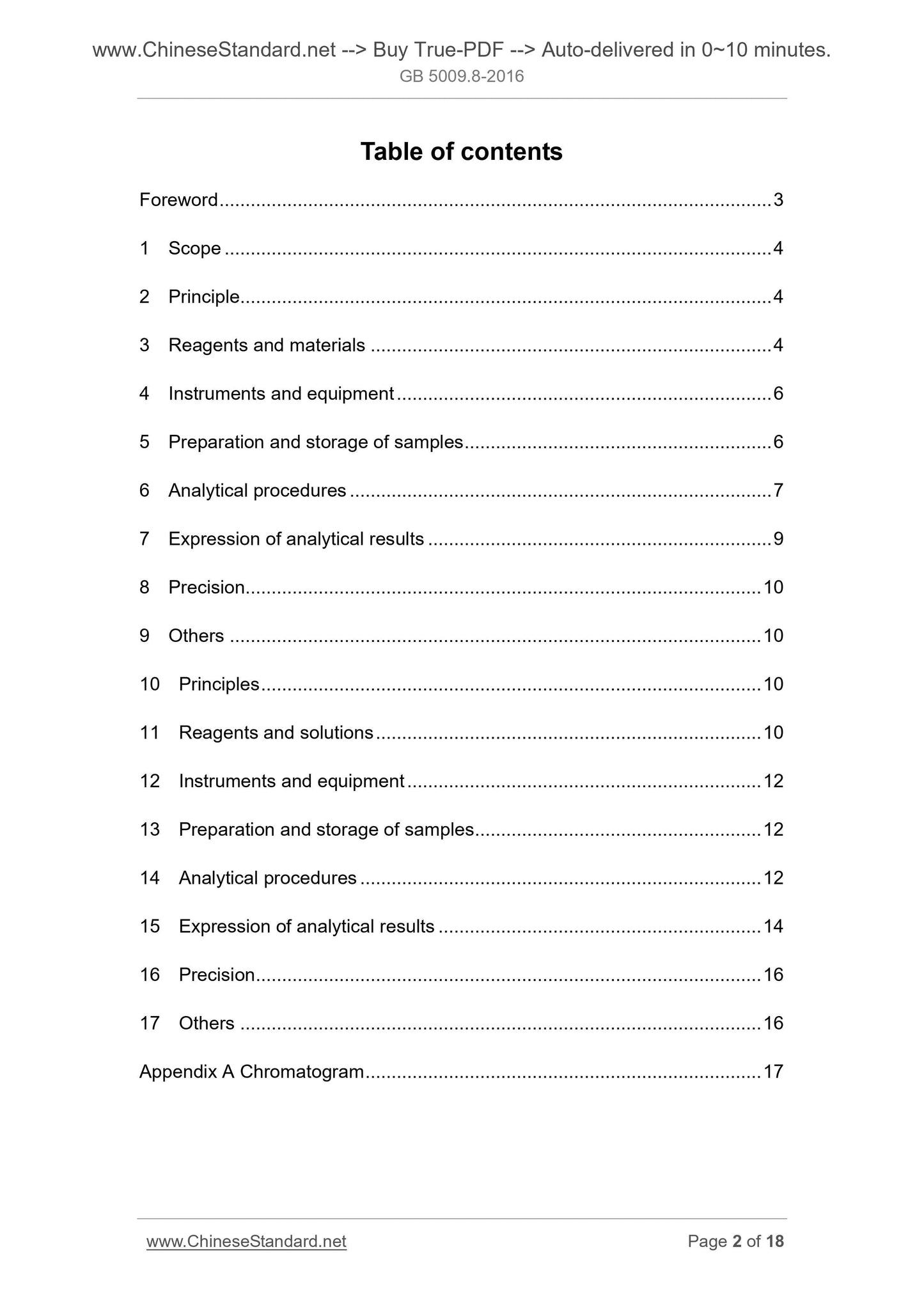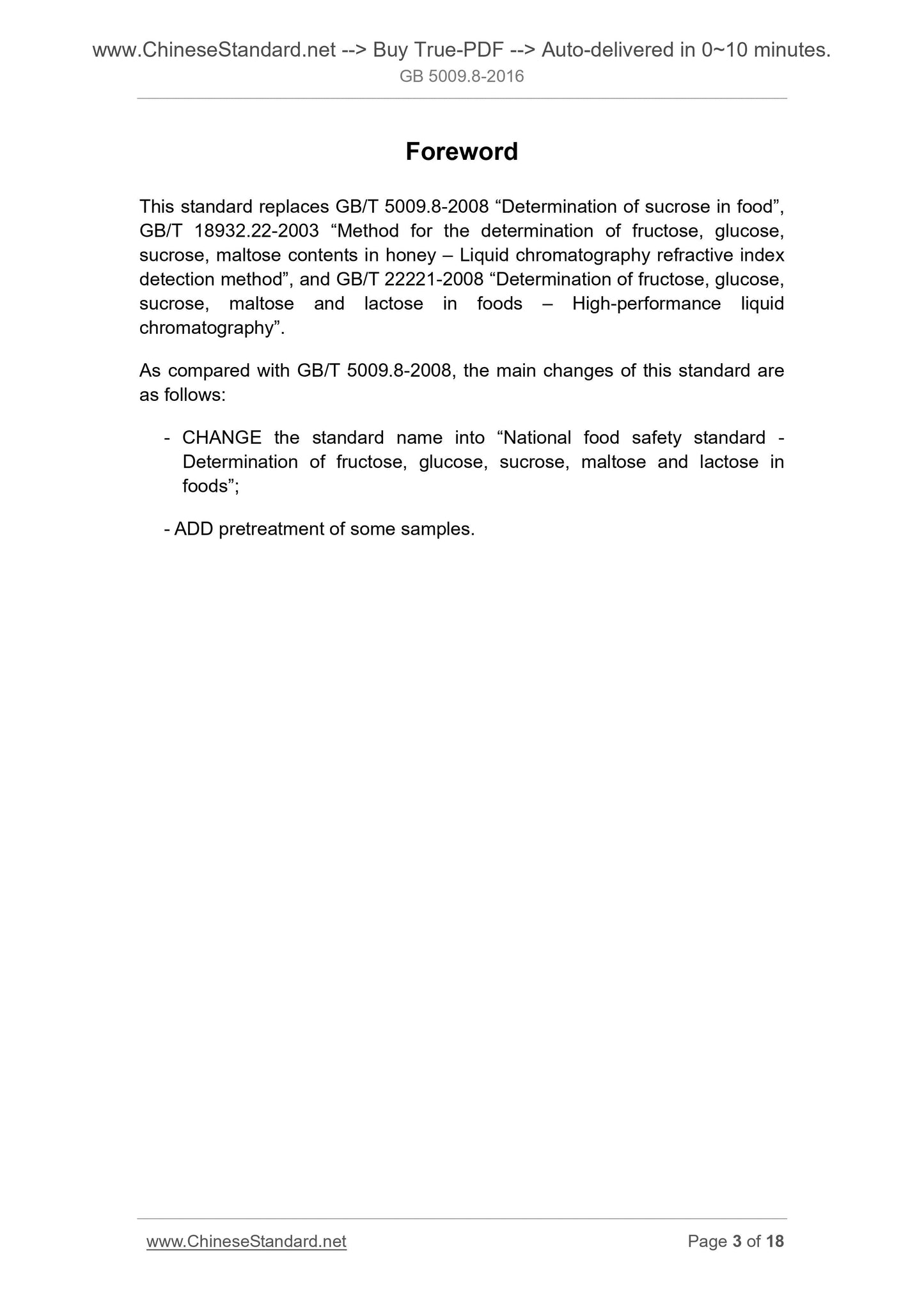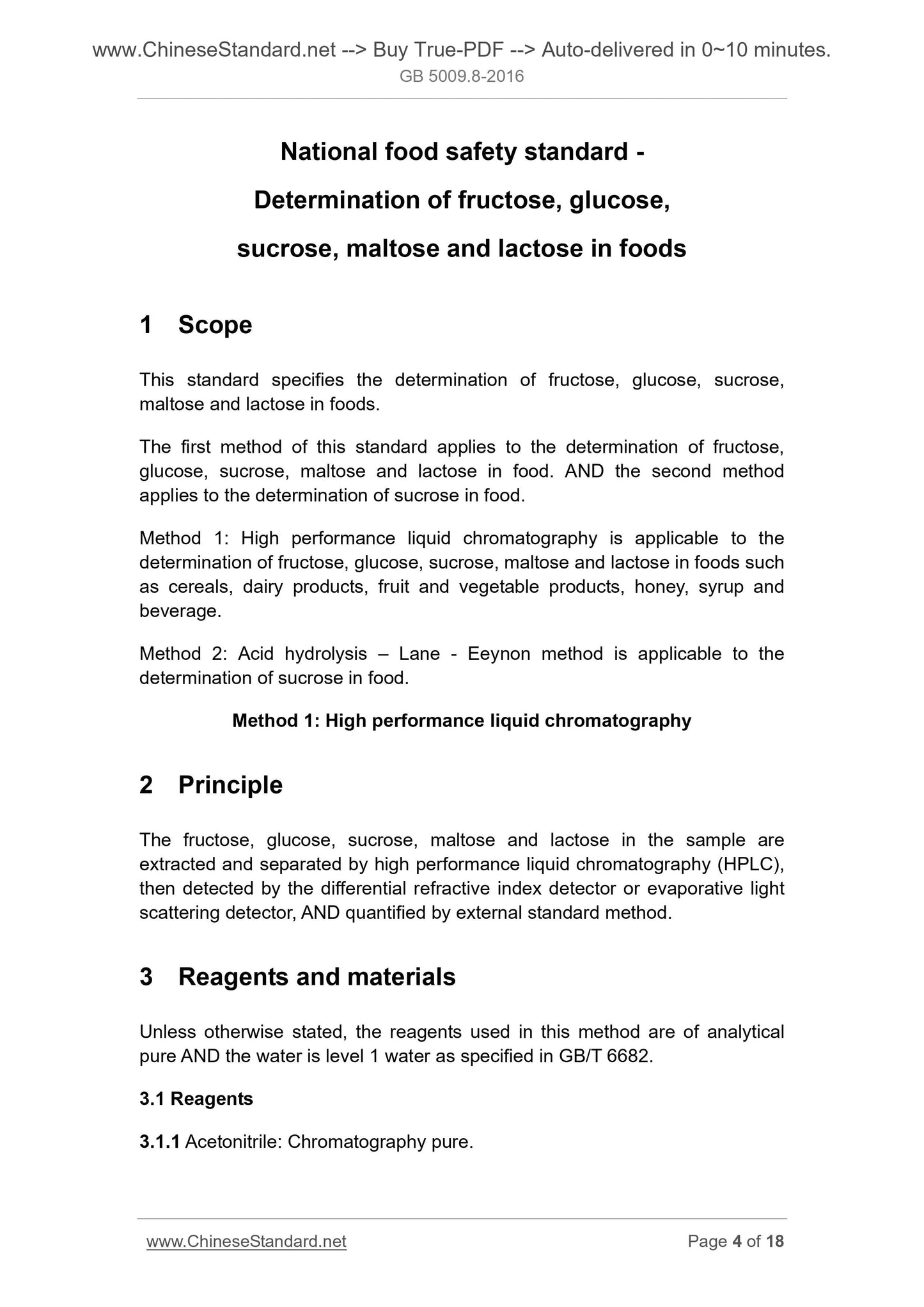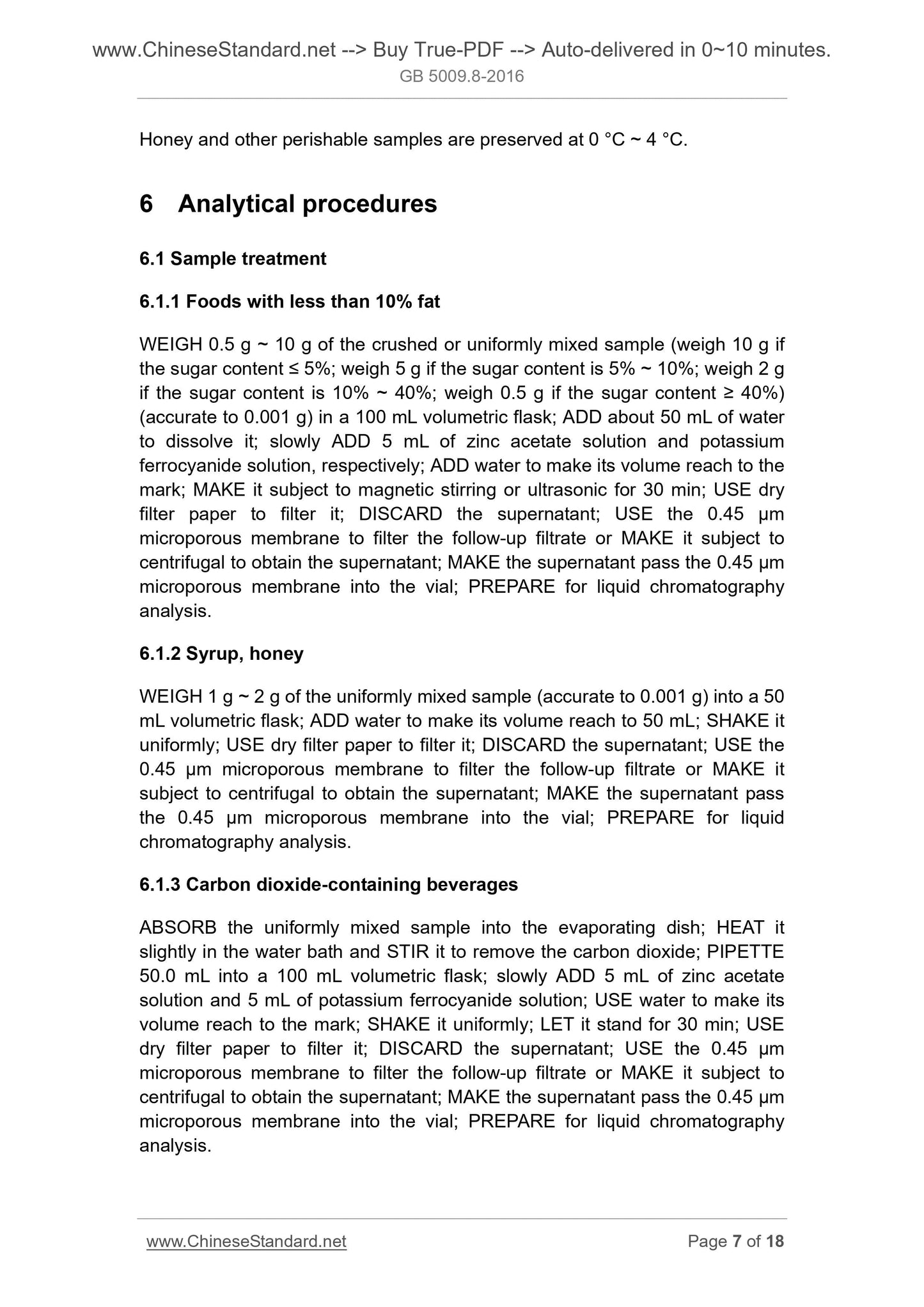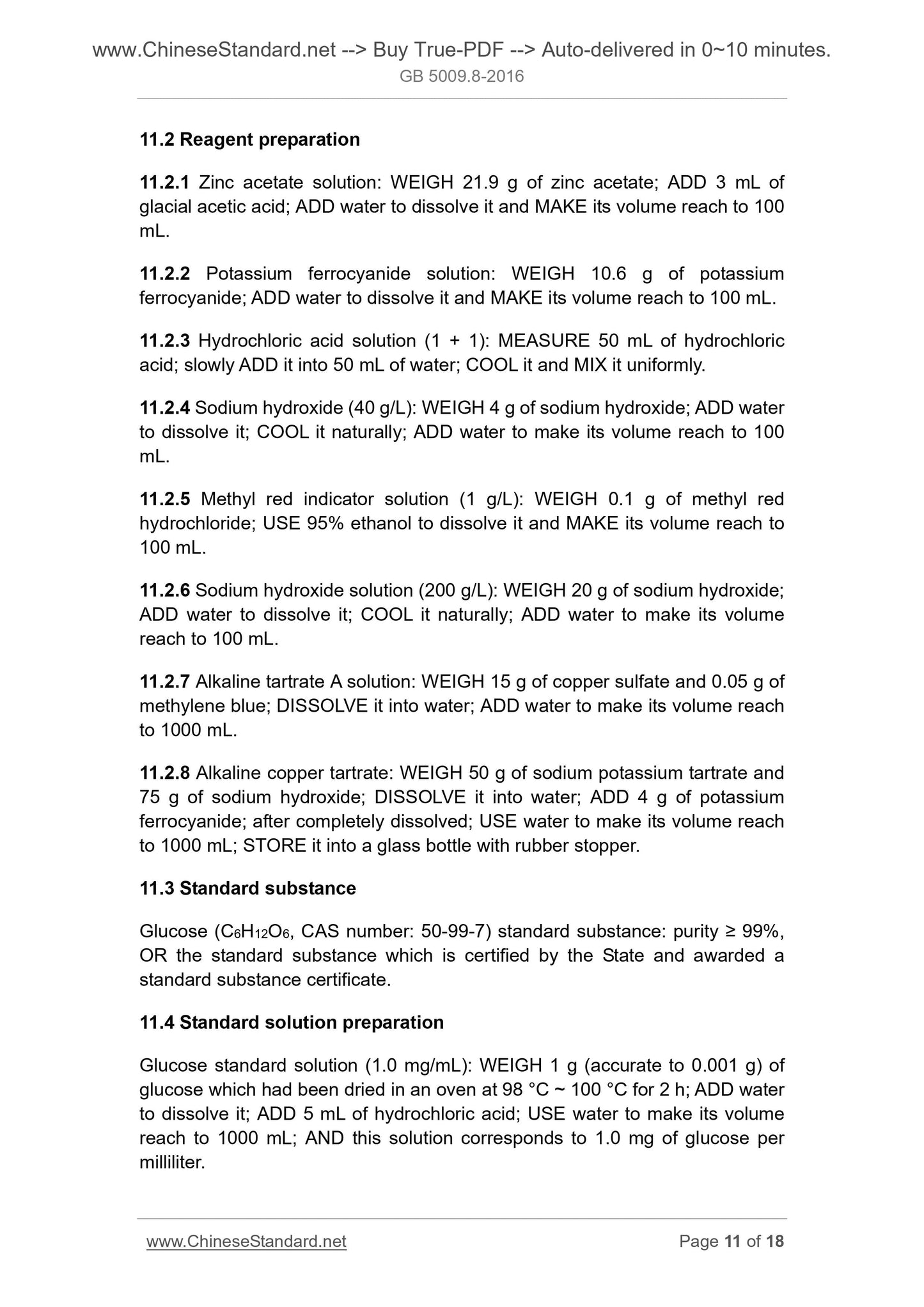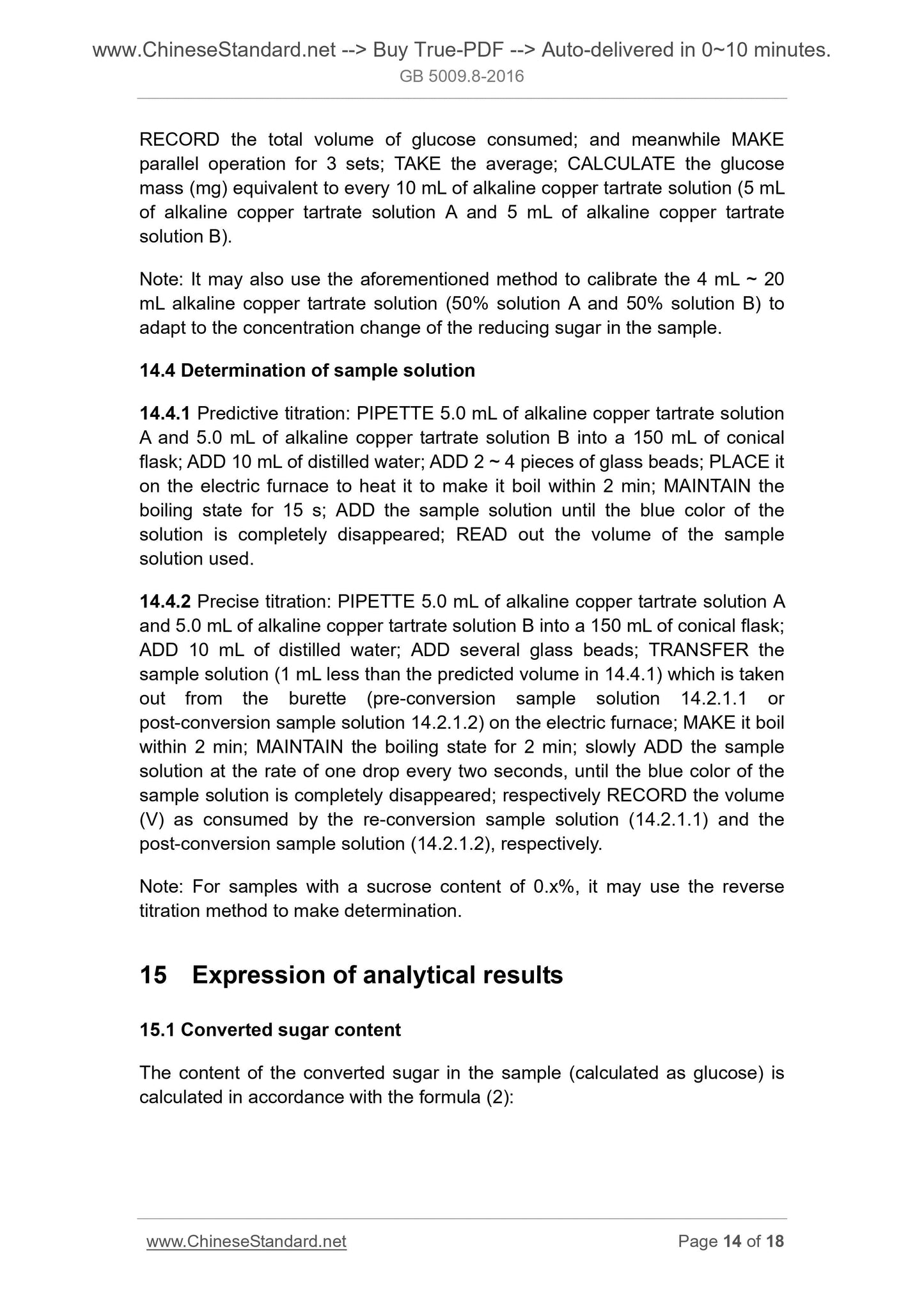1
/
of
7
PayPal, credit cards. Download editable-PDF & invoice in 1 second!
GB 5009.8-2016 English PDF (GB5009.8-2016)
GB 5009.8-2016 English PDF (GB5009.8-2016)
Regular price
$85.00 USD
Regular price
Sale price
$85.00 USD
Unit price
/
per
Shipping calculated at checkout.
Couldn't load pickup availability
Delivery: 3 seconds. Download true-PDF + Invoice.Newer version: (Replacing this standard) GB 5009.8-2023
Get QUOTATION in 1-minute: Click GB 5009.8-2016
Historical versions: GB 5009.8-2016
Preview True-PDF (Reload/Scroll if blank)
GB 5009.8-2016: Determination of saccharose in foods
GB 5009.8-2016
GB
NATIONAL STANDARD
OF THE PEOPLE’S REPUBLIC OF CHINA
National food safety standard -
Determination of fructose, glucose,
sucrose, maltose and lactose in foods
ISSUED ON. DECEMBER 23, 2016
IMPLEMENTED ON. JUNE 23, 2017
Issued by. National Health and Family Planning Commission of the PRC;
China Food and Drug Administration.
3. No action is required - Full-copy of this standard will be automatically and
immediately delivered to your EMAIL address in 0~60 minutes.
Table of contents
Foreword ... 3
1 Scope ... 4
2 Principle... 4
3 Reagents and materials ... 4
4 Instruments and equipment ... 6
5 Preparation and storage of samples ... 6
6 Analytical procedures ... 7
7 Expression of analytical results ... 9
8 Precision... 10
9 Others ... 10
10 Principles ... 10
11 Reagents and solutions ... 10
12 Instruments and equipment ... 12
13 Preparation and storage of samples ... 12
14 Analytical procedures ... 12
15 Expression of analytical results ... 14
16 Precision ... 16
17 Others ... 16
Appendix A Chromatogram ... 17
Foreword
This standard replaces GB/T 5009.8-2008 “Determination of sucrose in food”,
GB/T 18932.22-2003 “Method for the determination of fructose, glucose,
sucrose, maltose contents in honey – Liquid chromatography refractive index
detection method”, and GB/T 22221-2008 “Determination of fructose, glucose,
sucrose, maltose and lactose in foods – High-performance liquid
chromatography”.
As compared with GB/T 5009.8-2008, the main changes of this standard are
as follows.
- CHANGE the standard name into “National food safety standard -
Determination of fructose, glucose, sucrose, maltose and lactose in
foods”;
- ADD pretreatment of some samples.
National food safety standard -
Determination of fructose, glucose,
sucrose, maltose and lactose in foods
1 Scope
This standard specifies the determination of fructose, glucose, sucrose,
maltose and lactose in foods.
The first method of this standard applies to the determination of fructose,
glucose, sucrose, maltose and lactose in food. AND the second method
applies to the determination of sucrose in food.
Method 1. High performance liquid chromatography is applicable to the
determination of fructose, glucose, sucrose, maltose and lactose in foods such
as cereals, dairy products, fruit and vegetable products, honey, syrup and
beverage.
Method 2. Acid hydrolysis – Lane - Eeynon method is applicable to the
determination of sucrose in food.
Method 1. High performance liquid chromatography
2 Principle
The fructose, glucose, sucrose, maltose and lactose in the sample are
extracted and separated by high performance liquid chromatography (HPLC),
then detected by the differential refractive index detector or evaporative light
scattering detector, AND quantified by external standard method.
3 Reagents and materials
Unless otherwise stated, the reagents used in this method are of analytical
pure AND the water is level 1 water as specified in GB/T 6682.
3.1 Reagents
3.1.1 Acetonitrile. Chromatography pure.
Honey and other perishable samples are preserved at 0 °C ~ 4 °C.
6 Analytical procedures
6.1 Sample treatment
6.1.1 Foods with less than 10% fat
WEIGH 0.5 g ~ 10 g of the crushed or uniformly mixed sample (weigh 10 g if
the sugar content ≤ 5%; weigh 5 g if the sugar content is 5% ~ 10%; weigh 2 g
if the sugar content is 10% ~ 40%; weigh 0.5 g if the sugar content ≥ 40%)
(accurate to 0.001 g) in a 100 mL volumetric flask; ADD about 50 mL of water
to dissolve it; slowly ADD 5 mL of zinc acetate solution and potassium
ferrocyanide solution, respectively; ADD water to make its volume reach to the
mark; MAKE it subject to magnetic stirring or ultrasonic for 30 min; USE dry
filter paper to filter it; DISCARD the supernatant; USE the 0.45 μm
microporous membrane to filter the follow-up filtrate or MAKE it subject to
centrifugal to obtain the supernatant; MAKE the supernatant pass the 0.45 μm
microporous membrane into the vial; PREPARE for liquid chromatography
analysis.
6.1.2 Syrup, honey
WEIGH 1 g ~ 2 g of the uniformly mixed sample (accurate to 0.001 g) into a 50
mL volumetric flask; ADD water to make its volume reach to 50 mL; SHAKE it
uniformly; USE dry filter paper to filter it; DISCARD the supernatant; USE the
0.45 μm microporous membrane to filter the follow-up filtrate or MAKE it
subject to centrifugal to obtain the supernatant; MAKE the supernatant pass
the 0.45 μm microporous membrane into the vial; PREPARE for liquid
chromatography analysis.
6.1.3 Carbon dioxide-containing beverages
ABSORB the uniformly mixed sample into the evaporating dish; HEAT it
slightly in the water bath and STIR it to remove the carbon dioxide; PIPETTE
50.0 mL into a 100 mL volumetric flask; slowly ADD 5 mL of zinc acetate
solution and 5 mL of potassium ferrocyanide solution; USE water to make its
volume reach to the mark; SHAKE it uniformly; LET it stand for 30 min; USE
dry filter paper to filter it; DISCARD the supernatant; USE the 0.45 μm
microporous membrane to filter the follow-up filtrate or MAKE it subject to
centrifugal to obtain the supernatant; MAKE the supernatant pass the 0.45 μm
microporous membrane into the vial; PREPARE for liquid chromatography
analysis.
11.2 Reagent preparation
11.2.1 Zinc acetate solution. WEIGH 21.9 g of zinc acetate; ADD 3 mL of
glacial acetic acid; ADD water to dissolve it and MAKE its volume reach to 100
mL.
11.2.2 Potassium ferrocyanide solution. WEIGH 10.6 g of potassium
ferrocyanide; ADD water to dissolve it and MAKE its volume reach to 100 mL.
11.2.3 Hydrochloric acid solution (1 + 1). MEASURE 50 mL of hydrochloric
acid; slowly ADD it into 50 mL of water; COOL it and MIX it uniformly.
11.2.4 Sodium hydroxide (40 g/L). WEIGH 4 g of sodium hydroxide; ADD water
to dissolve it; COOL it naturally; ADD water to make its volume reach to 100
mL.
11.2.5 Methyl red indicator solution (1 g/L). WEIGH 0.1 g of methyl red
hydrochloride; USE 95% ethanol to dissolve it and MAKE its volume reach to
100 mL.
11.2.6 Sodium hydroxide solution (200 g/L). WEIGH 20 g of sodium hydroxide;
ADD water to dissolve it; COOL it naturally; ADD water to make its volume
reach to 100 mL.
11.2.7 Alkaline tartrate A solution. WEIGH 15 g of copper sulfate and 0.05 g of
methylene blue; DISSOLVE it into water; ADD water to make its volume reach
to 1000 mL.
11.2.8 Alkaline copper tartrate. WEIGH 50 g of sodium potassium tartrate and
75 g of sodium hydroxide; DISSOLVE it into water; ADD 4 g of potassium
ferrocyanide; after completely dissolved; USE water to make its volume reach
to 1000 mL; STORE it into a glass bottle with rubber stopper.
11.3 Standard substance
Glucose (C6H12O6, CAS number. 50-99-7) standard substance. purity ≥ 99%,
OR the standard substance which is certified by the State and awarded a
standard substance certificate.
11.4 Standard solution preparation
Glucose standard solution (1.0 mg/mL). WEIGH 1 g (accurate to 0.001 g) of
glucose which had been dried in an oven at 98 °C ~ 100 °C for 2 h; ADD water
to dissolve it; ADD 5 mL of hydrochloric acid; USE water to make its volume
reach to 1000 mL; AND this solution corresponds to 1.0 mg of glucose per
milliliter.
RECORD the total volume of glucose consumed; and meanwhile MAKE
parallel operation for 3 sets; TAKE the average; CALCULATE the glucose ...
Get QUOTATION in 1-minute: Click GB 5009.8-2016
Historical versions: GB 5009.8-2016
Preview True-PDF (Reload/Scroll if blank)
GB 5009.8-2016: Determination of saccharose in foods
GB 5009.8-2016
GB
NATIONAL STANDARD
OF THE PEOPLE’S REPUBLIC OF CHINA
National food safety standard -
Determination of fructose, glucose,
sucrose, maltose and lactose in foods
ISSUED ON. DECEMBER 23, 2016
IMPLEMENTED ON. JUNE 23, 2017
Issued by. National Health and Family Planning Commission of the PRC;
China Food and Drug Administration.
3. No action is required - Full-copy of this standard will be automatically and
immediately delivered to your EMAIL address in 0~60 minutes.
Table of contents
Foreword ... 3
1 Scope ... 4
2 Principle... 4
3 Reagents and materials ... 4
4 Instruments and equipment ... 6
5 Preparation and storage of samples ... 6
6 Analytical procedures ... 7
7 Expression of analytical results ... 9
8 Precision... 10
9 Others ... 10
10 Principles ... 10
11 Reagents and solutions ... 10
12 Instruments and equipment ... 12
13 Preparation and storage of samples ... 12
14 Analytical procedures ... 12
15 Expression of analytical results ... 14
16 Precision ... 16
17 Others ... 16
Appendix A Chromatogram ... 17
Foreword
This standard replaces GB/T 5009.8-2008 “Determination of sucrose in food”,
GB/T 18932.22-2003 “Method for the determination of fructose, glucose,
sucrose, maltose contents in honey – Liquid chromatography refractive index
detection method”, and GB/T 22221-2008 “Determination of fructose, glucose,
sucrose, maltose and lactose in foods – High-performance liquid
chromatography”.
As compared with GB/T 5009.8-2008, the main changes of this standard are
as follows.
- CHANGE the standard name into “National food safety standard -
Determination of fructose, glucose, sucrose, maltose and lactose in
foods”;
- ADD pretreatment of some samples.
National food safety standard -
Determination of fructose, glucose,
sucrose, maltose and lactose in foods
1 Scope
This standard specifies the determination of fructose, glucose, sucrose,
maltose and lactose in foods.
The first method of this standard applies to the determination of fructose,
glucose, sucrose, maltose and lactose in food. AND the second method
applies to the determination of sucrose in food.
Method 1. High performance liquid chromatography is applicable to the
determination of fructose, glucose, sucrose, maltose and lactose in foods such
as cereals, dairy products, fruit and vegetable products, honey, syrup and
beverage.
Method 2. Acid hydrolysis – Lane - Eeynon method is applicable to the
determination of sucrose in food.
Method 1. High performance liquid chromatography
2 Principle
The fructose, glucose, sucrose, maltose and lactose in the sample are
extracted and separated by high performance liquid chromatography (HPLC),
then detected by the differential refractive index detector or evaporative light
scattering detector, AND quantified by external standard method.
3 Reagents and materials
Unless otherwise stated, the reagents used in this method are of analytical
pure AND the water is level 1 water as specified in GB/T 6682.
3.1 Reagents
3.1.1 Acetonitrile. Chromatography pure.
Honey and other perishable samples are preserved at 0 °C ~ 4 °C.
6 Analytical procedures
6.1 Sample treatment
6.1.1 Foods with less than 10% fat
WEIGH 0.5 g ~ 10 g of the crushed or uniformly mixed sample (weigh 10 g if
the sugar content ≤ 5%; weigh 5 g if the sugar content is 5% ~ 10%; weigh 2 g
if the sugar content is 10% ~ 40%; weigh 0.5 g if the sugar content ≥ 40%)
(accurate to 0.001 g) in a 100 mL volumetric flask; ADD about 50 mL of water
to dissolve it; slowly ADD 5 mL of zinc acetate solution and potassium
ferrocyanide solution, respectively; ADD water to make its volume reach to the
mark; MAKE it subject to magnetic stirring or ultrasonic for 30 min; USE dry
filter paper to filter it; DISCARD the supernatant; USE the 0.45 μm
microporous membrane to filter the follow-up filtrate or MAKE it subject to
centrifugal to obtain the supernatant; MAKE the supernatant pass the 0.45 μm
microporous membrane into the vial; PREPARE for liquid chromatography
analysis.
6.1.2 Syrup, honey
WEIGH 1 g ~ 2 g of the uniformly mixed sample (accurate to 0.001 g) into a 50
mL volumetric flask; ADD water to make its volume reach to 50 mL; SHAKE it
uniformly; USE dry filter paper to filter it; DISCARD the supernatant; USE the
0.45 μm microporous membrane to filter the follow-up filtrate or MAKE it
subject to centrifugal to obtain the supernatant; MAKE the supernatant pass
the 0.45 μm microporous membrane into the vial; PREPARE for liquid
chromatography analysis.
6.1.3 Carbon dioxide-containing beverages
ABSORB the uniformly mixed sample into the evaporating dish; HEAT it
slightly in the water bath and STIR it to remove the carbon dioxide; PIPETTE
50.0 mL into a 100 mL volumetric flask; slowly ADD 5 mL of zinc acetate
solution and 5 mL of potassium ferrocyanide solution; USE water to make its
volume reach to the mark; SHAKE it uniformly; LET it stand for 30 min; USE
dry filter paper to filter it; DISCARD the supernatant; USE the 0.45 μm
microporous membrane to filter the follow-up filtrate or MAKE it subject to
centrifugal to obtain the supernatant; MAKE the supernatant pass the 0.45 μm
microporous membrane into the vial; PREPARE for liquid chromatography
analysis.
11.2 Reagent preparation
11.2.1 Zinc acetate solution. WEIGH 21.9 g of zinc acetate; ADD 3 mL of
glacial acetic acid; ADD water to dissolve it and MAKE its volume reach to 100
mL.
11.2.2 Potassium ferrocyanide solution. WEIGH 10.6 g of potassium
ferrocyanide; ADD water to dissolve it and MAKE its volume reach to 100 mL.
11.2.3 Hydrochloric acid solution (1 + 1). MEASURE 50 mL of hydrochloric
acid; slowly ADD it into 50 mL of water; COOL it and MIX it uniformly.
11.2.4 Sodium hydroxide (40 g/L). WEIGH 4 g of sodium hydroxide; ADD water
to dissolve it; COOL it naturally; ADD water to make its volume reach to 100
mL.
11.2.5 Methyl red indicator solution (1 g/L). WEIGH 0.1 g of methyl red
hydrochloride; USE 95% ethanol to dissolve it and MAKE its volume reach to
100 mL.
11.2.6 Sodium hydroxide solution (200 g/L). WEIGH 20 g of sodium hydroxide;
ADD water to dissolve it; COOL it naturally; ADD water to make its volume
reach to 100 mL.
11.2.7 Alkaline tartrate A solution. WEIGH 15 g of copper sulfate and 0.05 g of
methylene blue; DISSOLVE it into water; ADD water to make its volume reach
to 1000 mL.
11.2.8 Alkaline copper tartrate. WEIGH 50 g of sodium potassium tartrate and
75 g of sodium hydroxide; DISSOLVE it into water; ADD 4 g of potassium
ferrocyanide; after completely dissolved; USE water to make its volume reach
to 1000 mL; STORE it into a glass bottle with rubber stopper.
11.3 Standard substance
Glucose (C6H12O6, CAS number. 50-99-7) standard substance. purity ≥ 99%,
OR the standard substance which is certified by the State and awarded a
standard substance certificate.
11.4 Standard solution preparation
Glucose standard solution (1.0 mg/mL). WEIGH 1 g (accurate to 0.001 g) of
glucose which had been dried in an oven at 98 °C ~ 100 °C for 2 h; ADD water
to dissolve it; ADD 5 mL of hydrochloric acid; USE water to make its volume
reach to 1000 mL; AND this solution corresponds to 1.0 mg of glucose per
milliliter.
RECORD the total volume of glucose consumed; and meanwhile MAKE
parallel operation for 3 sets; TAKE the average; CALCULATE the glucose ...
Share
